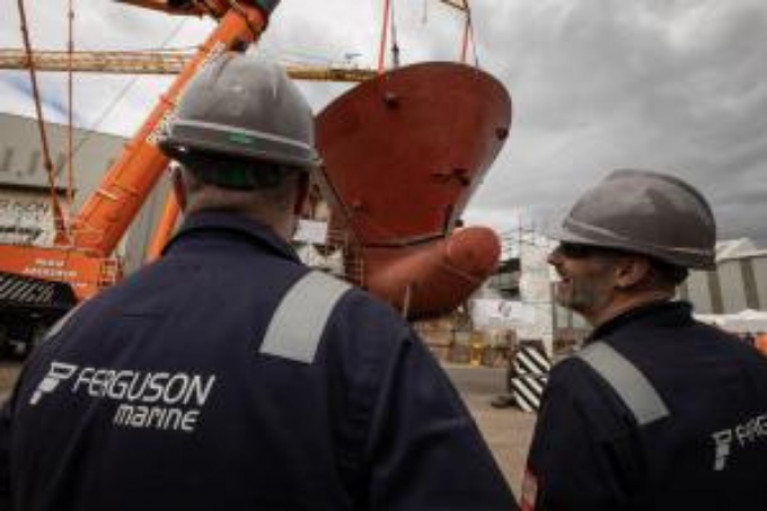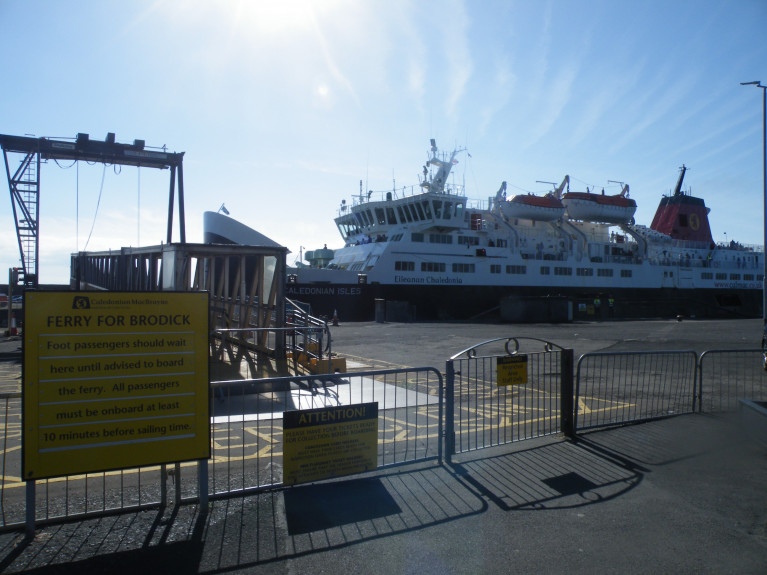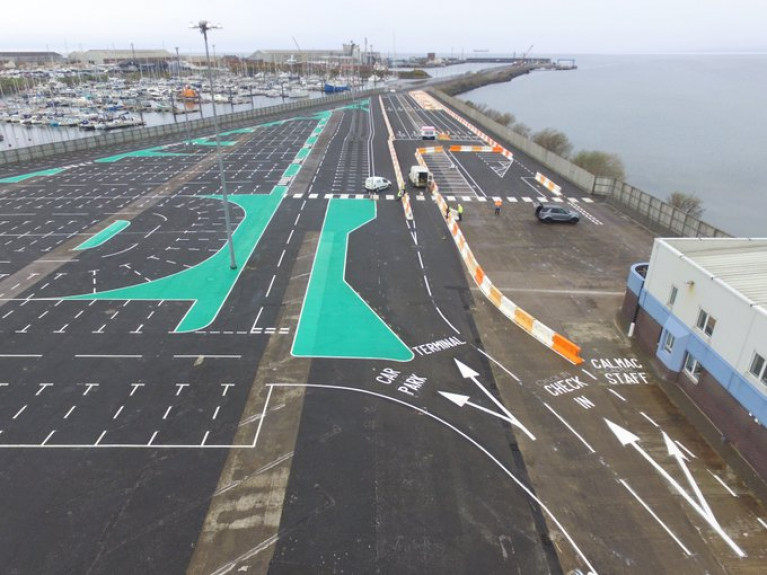Displaying items by tag: CalMac
Bad Weather on Firth of Clyde Sees CalMac's MV Hebridean Isles Forced to Relocate to Ayr
On the Firth of Clyde a Caledonian MacBrayne (CalMac) ferry which has been plagued by technical problems for almost six months, has been seen at a berth in Ayr harbour.
The port of Ayr, operated by Associated British Ports is located south of Troon and also Ardrossan from where the ferry route connects Brodick, Isle of Arran.
The 1985 built ferry MV Hebridean Isles, one of oldest in the fleet, made for an unusual sight at Ayr as CalMac was forced to change the usual berthing arrangements for its ageing Arran ferries due to the bad weather.
Hebridean Isles was seen arriving into Ayr on the morning of Tuesday, 1 August in a passage from Troon which Afloat adds took around 40 minutes to complete and the ferry remains in Ayr this morning, 3 August.
The 494 passenger ferry, one of two serving Islay-Kennacraig, Isle of Mull (see above Afloat photo) was deployed to the Arran run but has been unable to operate since February because of 'manoeuvrability issues'. This has forced CalMac to charter the 430 passenger and vehicle catamaran, MV Alfred, from private operator Pentland Ferries serving South Ronaldsay, one of the Orkney Islands.
The 3,040 gross tonnage Hebridean Isles has been berthed in Troon (see Arran 'freight' run) in efforts to continue to try and fix technical problems.
Due to the "lack of space" however, Hebridean Isles was forced to head for Ayr, as the bad weather was forecast on the Clyde which also restricted the use of berthing facilities at Ardrossan harbour.
A spokesperson for CalMac said: "Due to adverse weather forecast on Wednesday, August 2, MV Caledonian Isles will berth overnight on the Irish berth in Ardrossan tonight (Tuesday, August 1)".
"As a result, MV Alfred will relocate to Troon for overnight berthing tonight. Due to lack of space at Troon, and to accommodate the relocation of MV Alfred, MV Hebridean Isles has been requested to temporarily move to Ayr."
More from theAyr Advertiser on the Clyde route and the redeployment of the Isle of Arran, the second routine ferry on the Ardrossan-Brodick route.
Ferry Operator CalMac - Behind the Scenes Series On Serving Scotland's West Coast Isles & Communities
Ferry operator Caledonian MacBrayne (CalMac) will be the focus of a new fly-on-the-wall T.V. documentary series which will show the work and life aboard their services to Scotand's west coast island communities that it connects.
The first of the eight episodes of 'Island Crossings' is to be screened today, Sunday at 9pm on the BBC Scotland channel as Afloat previously reported.
CalMac which this year celebrates its 50th anniversary, operates the largest ferry fleet in Britain of 35 (albeit in domestic waters) across 26 islands, running more than 500 sailings every day, operating 29 different routes.
Among the extensive route network are those that connect Arran (see ferry trip) Harris, Islay and Skye and dozens of smaller islands to mainland Scotland and inter-island services.
In tonight's opening episode, Ardrossan, the port for the Isle of Arran on the Firth of Clyde, is where port terminal assistants Kirsty and Debra -– who was only four weeks into the job at the time. They have to deal with complaints and concerns from thousands of passengers bound for Brodick Highland Games, including Kilbarchan Pipe Band members, as they are left waiting indefinitely after MV Caledonian Isles (see photo) breaks down (see CalMac's Arran service update) on the busiest day of the year.
The programme also features Isle of Mull youngster Oscar leave home, just as hundreds of other islander pupils have to do when they reach secondary school age. The school goers early on Monday mornings take the ferry crossing to spend the week on the mainland in Oban at the school hostel.
InverClydeNow has more on the new documentary series.
Scottish government owned ferry operator CalMac have confirmed the new timetable for the catamaran MV Alfred which is to serve on the Forth of Clyde route between Ardrossan and the Isle of Arran.
According to the Ardrossan & Saltcoats Herald, announcement follows a a successful familiarisation period of recent weeks for the ferry which Afloat adds usually operates on the Pentland Firth between the mainland and Orkney Islands.
As previously reported Scottish ministers have chartered the 430 passenger /98 car carrying catamaran for nine months at a cost of £9 million.
The charter from Pentland Ferriesis in a bid to ease the growing ferry crisis on west coast and isles services where technical problems have beset ferries.
Below is a timetable for the catamaran operate until Thursday, 29 June:
Friday – Monday
Depart Ardrossan - 08:00, 11:30 and 16:15
Depart Brodick - 09:45, 13:15 and 18:00
Tuesday – Thursday
Depart Ardrossan - 08:00 and 16:15
Depart Brodick - 09:45 and 18:00
During this time period, CalMac has advised that all passengers will require to access the vessel via the catamaran's stern ramp.
More here on the catamaran's entry into service and for further service information, click the CalMac's website.
Scottish Operator's Main Isle of Arran Ferry Breaks Down with Air Leak
In south-west Scotland, repairs to the ferry Caledonian Isles in Brodick (Arran) forced the cancellation of two return sailings to Ardrossan on one of CalMac’s busiest routes.
CalMac said a secondary vessel, Isle of Arran, continued to operate on the route.
The operator said later the fault had been fixed and Caledonian Isles would return to service for (yesterday's 14 Sept) 19:20 sailing from Brodick.
CalMac had tweeted (also yesterday): “Due to an issue with the vessel’s starboard main engine which requires further investigations and repairs, the following sailings have now been cancelled: Depart Brodick - 13:55, 16:40, Depart Ardrossan - 15:20, 18:00.”
The fault is the latest to hit the 29-year-old ferry, which was out of service for more than two weeks at the start of the tourist season in mid-April because of an engine failure.
It should have been replaced by the hugely-delayed Glen Sannox four years ago, but the ferry being built at the Ferguson Marine shipyard in Port Glasgow is not now expected to be completed until between March and May 2023.
Sea trials will follow, so the vessel may not be in service until autumn next year, leaving Arran at heightened risk of further disruption for another summer.
More The Scotsman reports of CalMac's ageing fleet.
BBC Series of Behind the Scenes Documentary Will Showcase CalMac and Its Ferry Crew
A new BBC documentary series will go behind the scenes to report on the working lives of the crew and staff who serve the Scottish west coast communities across the CalMac ferry network.
It will also focus on many of the people and communities which depend on CalMac, exploring their way of life and livelihoods.
The series is being created by IWC Media, the production company behind Susan Calman's Secret Scotland (Channel 5), Scotland's Home of The Year (BBC One) and Location, Location, Location (Channel 4).
Filming will be observational - capturing normal jobs and duties as they happen to represent what goes on behind the scenes at CalMac. Staff are not under any obligation to be filmed and the documentary production company will ensure that operational procedures are not affected.
Robbie Drummond, Managing Director of CalMac, said: "Communities have faced an awful lot of upheaval recently and we understand just how deeply this has affected them. This documentary will not gloss over these problems but is an opportunity to highlight the importance of the ferry service to people's lives.
"This is a chance for us to show who we really are and the lengths our people go to every day to deliver our services.
"It will showcase the people who regularly use the ferry service and to promote the unique local businesses operating within the islands, all of whom rely on CalMac."
Clydeside shipyard Ferguson Marine announced on Monday, the completion of a major milestone in the build of one of the dual fuel ferries currently under construction.
Hull 802, as the vessel is currently known, was fitted with its large bow unit which is the largest single unit added to the ferry’s steel hull, completing the bow structure.
This week will mark a key moment in the vessel’s progress when the final units are lifted into place, completing the main hull and steelwork and making way for the installation of the ferry’s aluminium superstructure, which is all the units that sit above the main deck.
Over the coming weeks and months, resources will ramp up to around 150 people working on Hull 802 to support the construction effort.
The National has more on the Port Glasgow yard which Afloat adds is constructing the ferry for CalMac's Uig Triangle service.
Whereas the first ferry when completed, Glen Sannox is to serve on the Arran service on the Firth of Clyde.
Stricken Scottish Ferry Out of Action on Arran Service Until May 3, CalMac Announces
Scottish-state owned ferry operator, CalMac is now looking at redeploying or chartering other vessels to help meet demand because it has no spare large ferries available.
Caledonian Isles is being repaired in Troon (see related story) after suffering an engine failure and hitting the harbour in Ardrossan on Sunday during the busiest (Easter) weekend so far this year.
The Isle of Arran, a substitute ferry drafted in to take over the main Ardrossan-Brodick route – one of CalMac’s busiest – can only carry half as many vehicles, which has caused major disruption to travel to and from the island.
CalMac has cancelled all bookings on the Firth of Clyde route.
This has meant that all but priority drivers, such as those carrying food and fuel supplies and people going to health appointments, are having to queue for sailings.
The engine which failed had undergone routine maintenance fewer than three months ago, the company told The Scotsman which more more on the story.
Upgraded Ferry Terminal at ABP’s Port of Troon Now Completed
An upgraded ferry terminal at the Scottish port of Troon, operated by Associated British Ports (ABP) has been announced following marine works including new berthing fenders and a suspended concrete deck were completed.
The works carried out by civil engineering contractor George Leslie, are to support the CalMac ferry service to Ardrossan-Brodick/Campbeltown when it temporarily relocates to Troon (see Easter ferry related story) as part of the Ardrossan Harbour Project.
With the marine works complete, the focus at Troon now shifts to the completion of the required shoreside infrastructure, including the installation of a modular terminal building, extensive car parking, check-in lanes and pickup and drop-off areas. All of these works are scheduled to be completed by this summer
Commenting on the project’s completion, ABP’s Regional Director Andrew Harston said: “It is great to reach such an important milestone in the project and I am hugely proud of the local ABP team and our civil engineering contractors, George Leslie, who have worked so well together to deliver this on time and within budget.”
The berth upgrade has been designed to accommodate both of CalMac’s existing ferries and the newbuild M.V.Glen Sannox class of vessel which is due to enter into service next year.
Andrew Harston commented: “We are hopeful that the Port of Troon’s sheltered East Pier berth and track record of offering all-weather berthing will play a major part in helping to support the Arran communities call for improvements in terms of the reliability and resilience of ferry services to the island.”
Cancellation Chaos after Firth of Clyde Ferry Crashes At Ardrossan Harbour Wall Breaks Engine
Firth of Clyde ferry crossings to the Isle of Arran were removed from service on Tuesday as engineers tried to fix a broken engine.
The cancellations left just one vessel operating on the main route from Ardrossan (to Brodick), with ferry operator CalMac encouraging visitors to board by foot where possible.
Providing an update to the disruption on their website, CalMac said: “We are currently working on a repair plan which will require MV Caledonian Isles to move to an alternative port. A further update will be provided when available.
“We would encourage customers to travel as foot passengers where possible.”
Sailings at 7am, 9.45am, 12.30pm, 3.20pm and 6pm from Ardrossan and those at 8.20am, 11.05am, 1.55pm, 4.40pm and 7.20pm from Brodick were cancelled.
It comes after the Caledonian Isles vessel hit a harbour wall on Sunday, resulting in the shutting down of one engine.
STV News has more on the incident that took place during the busy Easter weekend.
Scottish Operator CalMac Issues Statement of 'Shock' in Support to Sacked P&O Seafarers
Workers of P&O Ferries left jobless by their employer have been urged to apply for positions with Caledonian MacBrayne (CalMac).
CalMac's managing director Robbie Drummond said in a statement he was "shocked" by the news 800 seafarers had been thrown out by P&O yesterday without notice.
And he invited them to come and work for him instead. He said: "We at CalMac were shocked and saddened to hear about the redundancies at P&O Ferries. This is an awful situation for our many ferry industry colleagues.
"We have vacancies currently available, including a number of deck ratings and seaman pursers required to start in April, and would encourage anyone affected to apply as soon as possible."
There are currently 16 deck ratings vacancies and one spot for a seaman purser.
P&O operates UK-mainland Europe routes in addition between Scotland and Northern Ireland via Cairnryan-Larne and on the Irish Sea the Dublin-Liverpool link (see Blackpool related story).
The National has more on the story including vacancies currently with CalMac which Afloat adds is a subsidiary of the Scottish goverment owned David MacBrayne.

































































